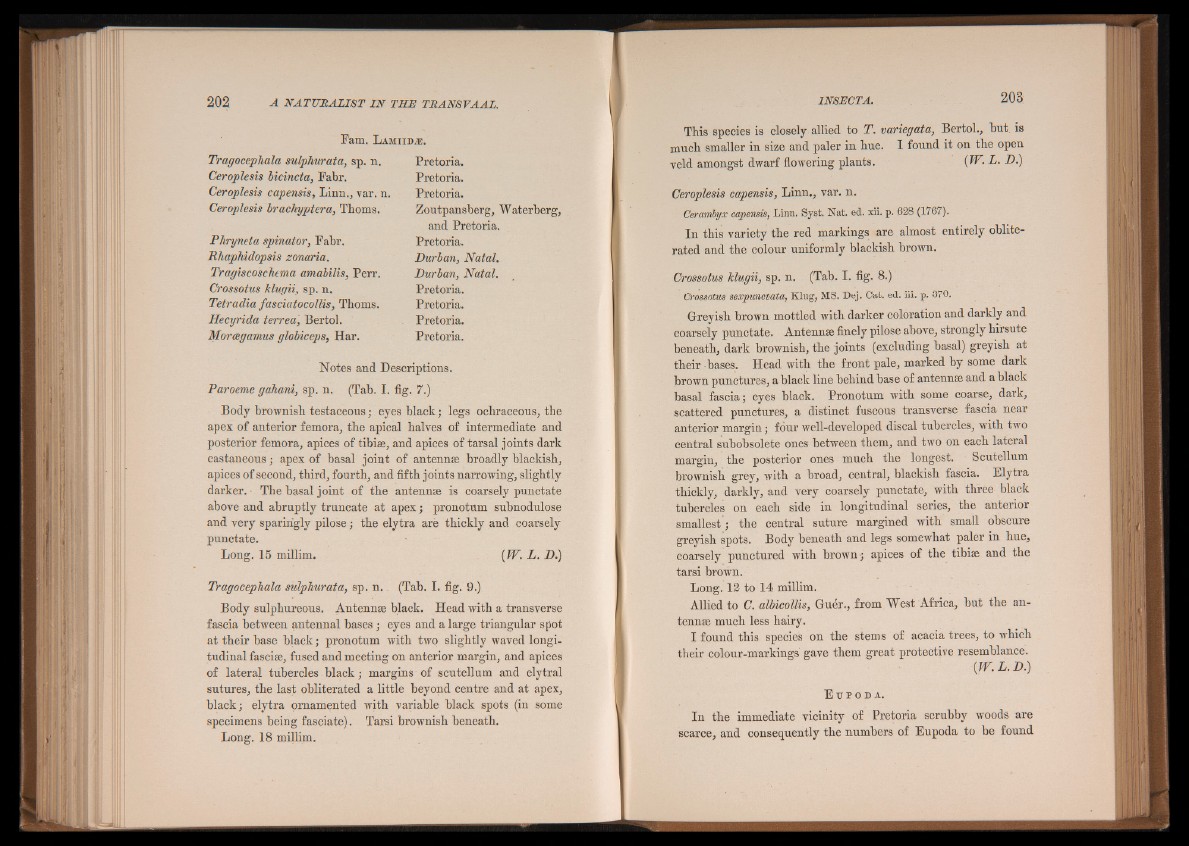
Fam. LamiidjE.
Tragocephala sulphurata, sp. n. Pretoria.
Ceroplesis bicincta, Fabr. Pretoria.
Ceroplesis capensis, Linn., var. n. Pretoria.
Ceroplesis brachyptera, Thoms. Zoutpansberg, Waterberg,
and Pretoria.
Phryneta spinator, Fabr. Pretoria.
Rkaphidopsis zonaria. Durban, Natal.
Tragiscoschema amabilis, Perr. Durban, Natal.
Crossotus Mugii, sp. n. Pretoria.
Tetradia fasciatocollis, Thoms. Pretoria.
Hecyrida terrea, Bertol. Pretoria.
Morcegamus globiceps, Har. Pretoria.
Notes and Descriptions.
Paroeme gdhani, sp. n. (Tab. X. fig. 7.)
Body brownish testaceous; eyes black; legs ochraceous, the
apex of anterior femora, the apical halves of intermediate and
posterior femora, apices of tibiae, and apices of tarsal joints dark
castaneous; apex of basal joint of antennae broadly blackish,
apices of second, third, fourth, and fifth joints narrowing, slightly
darker. The basal joint of the antennae is coarsely punctate
above and abruptly truncate at apex; pronotum subnodulose
and very sparingly pilose; the elytra are thickly and coarsely
punctate.
Long. 15 millim. (W. L. D.)
Tragocephala sulphurata, sp. n .. (Tab. I. fig. 9.)
Body sulphureous. Antennae black. Head with a transverse
fascia between antennal bases ; eyes and a large triangular spot
at their base black; pronotum with two slightly waved longitudinal
fasciae, fused and meeting on anterior margin, and apices
of lateral tubercles black; margins of scutellum and elytral
sutures, the last obliterated a little beyond centre and at apex,
black; elytra ornamented with variable black spots (in some
specimens being fasciate). Tarsi brownish beneath.
Long. 18 millim.
This species is closely allied to T. variegata, Bertol., but. is
much smaller in size and paler in hue. I found it on the open
veld amongst dwarf flowering plants. (W .L .D .)
Ceroplesis capensis, Linn., var. n.
Cerambyx capensis, Linn. Syst. Nat. ed. xii. p. 628 (1767).
In this variety the red markings are almost entirely obliterated
and the colour uniformly blackish brown.
Crossotus klugii, sp. n. (Tab. I. fig. 8.)
Crossotus sexpunctata, Klug, MS. Dej. Oat. ed. iii. p. 370.
Greyish brown mottled with darker coloration and darkly and
coarsely punctate. Antennae finely pilose above, strongly hirsute
beneath, dark brownish, the joints (excluding basal) greyish at
their bases. Head with the front pale, marked by some dark
brown punctures, a black line behind base of antennae and a black
basal fascia; eyes black. Pronotum with some coarse, dark,
scattered punctures, a distinct fuscous transverse fascia near
anterior margin ; four well-developed discal tubercles, with two
central subobsolete ones between them, and two on each lateral
margin, the posterior ones much the longest. Scutellum
brownish grey, with a broad, central, blackish fascia. Elytra
thickly, darkly, and very coarsely punctate, with three black
tubercles on each side in longitudinal series, the anterior
smallest; the central suture margined with small obscure
greyish spots. Body beneath and legs somewhat paler in hue,
coarsely punctured with brown; apices of the tibiae and the
tarsi brown.
Long. 12 to 14 millim.
Allied to C. albicollis, Guer., from West Africa, but the antennae
much less hairy.
I found this species on the stems of acacia trees, to which
their colour-markings gave them great protective resemblance.
{W. L. D.)
E u v o n a .
In the immediate vicinity of Pretoria scrubby woods are
scarce, and consequently the numbers of Eupoda to be found